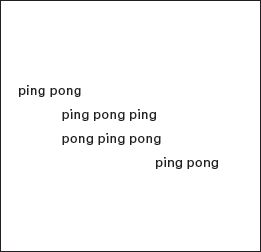6
The Typographic Message
This chapter introduces typography as a language of potent visible signs, a language capable of educating, persuading, informing, and entertaining. When typographic signs are created with an informed eye and mind, they can achieve clarity, expression, lucidity, aesthetic beauty, and more. Typographic messages pervade our culture to the degree that they are often taken for granted or not noticed at all, but those that are etched into the mind and memory are characterized by a relationship between content and form.
A MULTIDIMENSIONAL LANGUAGE

6-1 “ping pong” (Poet: Eugen Gomringer)
The typographic message is verbal, visual, and vocal. While typography is read and interpreted verbally, it may also be viewed and interpreted visually, heard and interpreted audibly. It is a dynamic communication medium. In this sense, early twentieth-century typography became a revolutionary form of communication, bringing new expressive power to the written word. Consider the concrete poem “ping pong” (Fig. 6-1). The geometric structure of this poem is composed of a repetition of the words ping and pong. As these words are repeated, they signify the sound of a bouncing ping-pong ball, and the circular letters p, o, and g reflect the shape of the ball. The full impact of this poem is achieved when it is read aloud. By hearing the sounds while viewing the typographic forms, ...
Get Typographic Design: Form and Communication, 6th Edition now with the O’Reilly learning platform.
O’Reilly members experience books, live events, courses curated by job role, and more from O’Reilly and nearly 200 top publishers.

